MODERN ENGLISH LEXICOLOGY Word-Formation in Modern English Problems

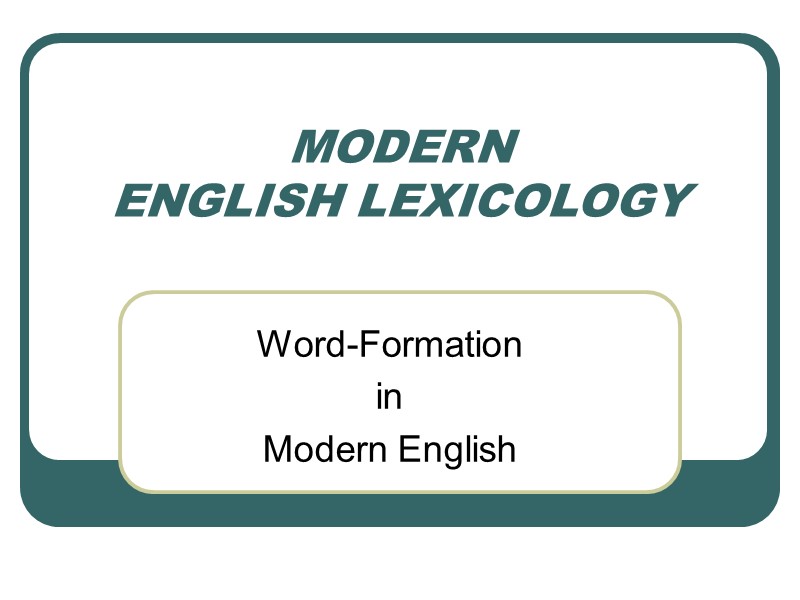
MODERN ENGLISH LEXICOLOGY Word-Formation in Modern English
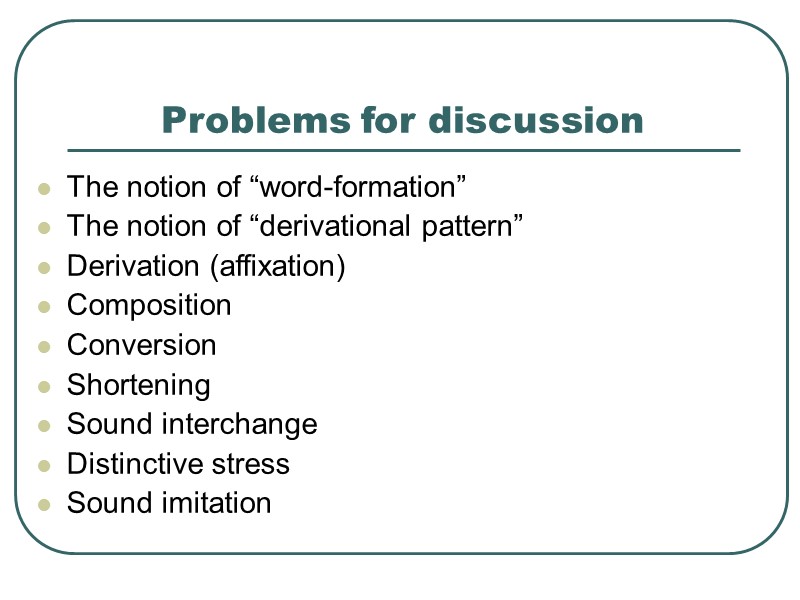
Problems for discussion The notion of “word-formation” The notion of “derivational pattern” Derivation (affixation) Composition Conversion Shortening Sound interchange Distinctive stress Sound imitation
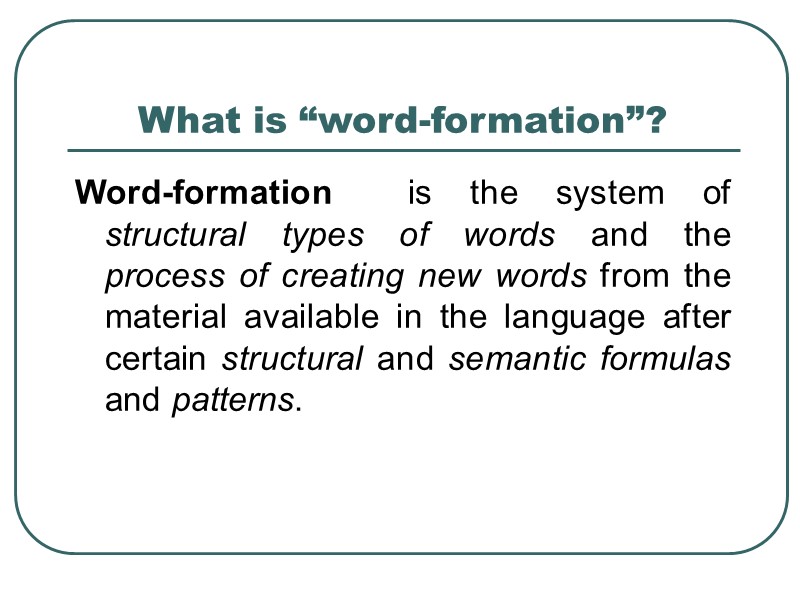
What is “word-formation”? Word-formation is the system of structural types of words and the process of creating new words from the material available in the language after certain structural and semantic formulas and patterns.
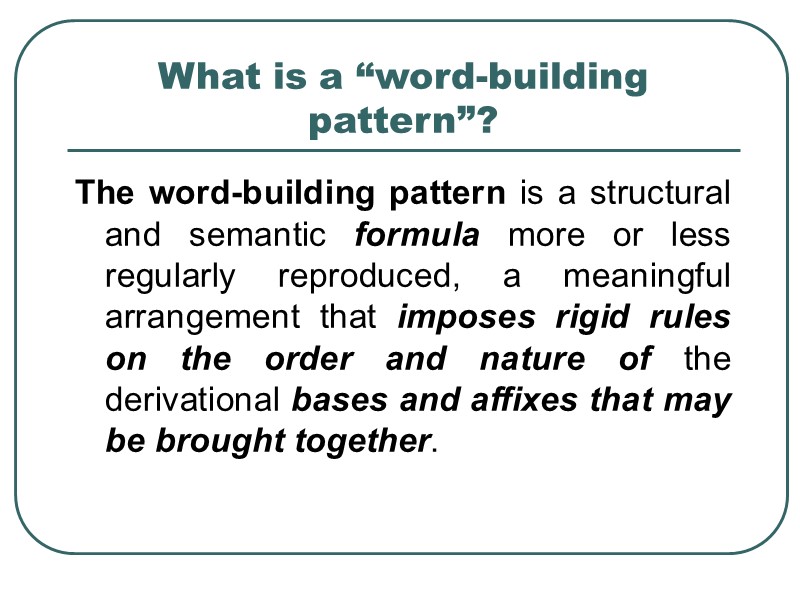
What is a “word-building pattern”? The word-building pattern is a structural and semantic formula more or less regularly reproduced, a meaningful arrangement that imposes rigid rules on the order and nature of the derivational bases and affixes that may be brought together.
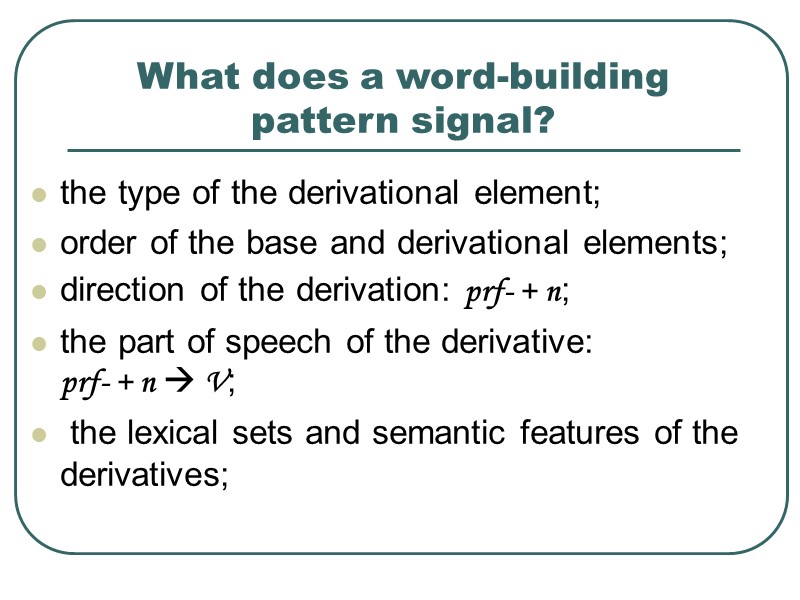
What does a word-building pattern signal? the type of the derivational element; order of the base and derivational elements; direction of the derivation: prf- + n; the part of speech of the derivative: prf- + n V; the lexical sets and semantic features of the derivatives;

What does the combining power (valency) of word building elements depend on? phono-morphological factors (–ance/-ence occurs only after b, t, d, dz, v, l, r, m, n); morphological factors (-able can be added to verbs to form adjectives); semantic factors (-ness (in nouns) the condition, quality, or degree of being: loudness).
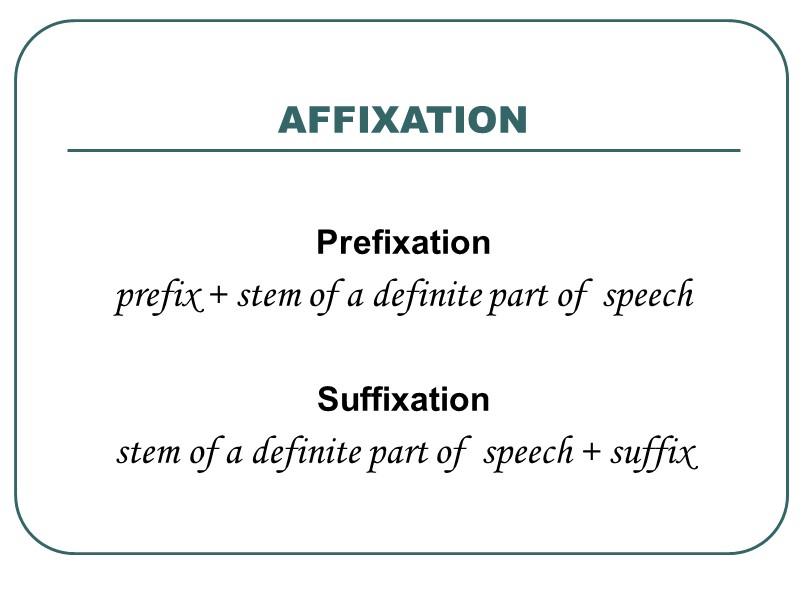
AFFIXATION Prefixation prefix + stem of a definite part of speech Suffixation stem of a definite part of speech + suffix
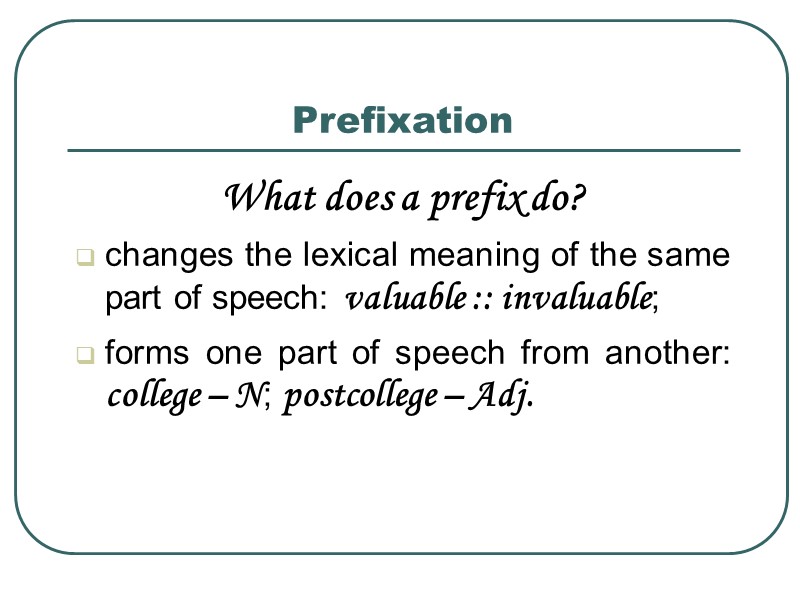
Prefixation What does a prefix do? changes the lexical meaning of the same part of speech: valuable :: invaluable; forms one part of speech from another: college – N; postcollege – Adj.
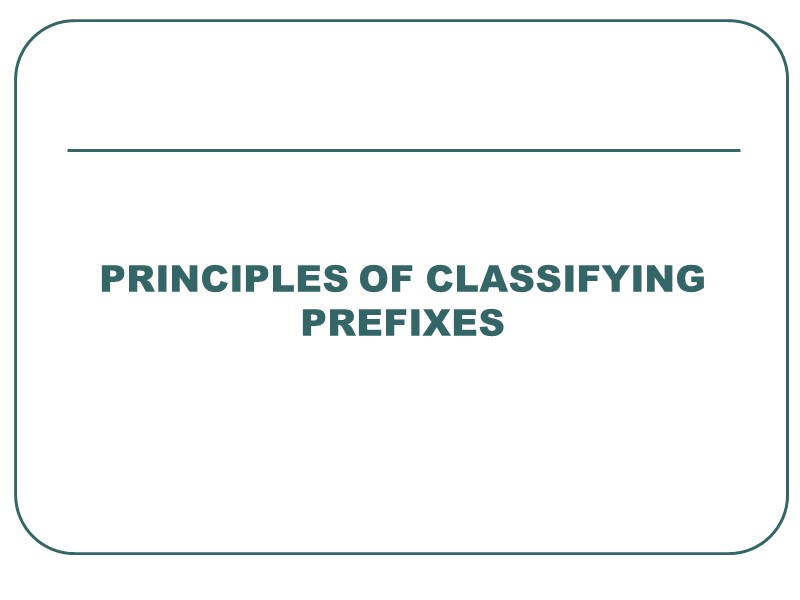
PRINCIPLES OF CLASSIFYING PREFIXES
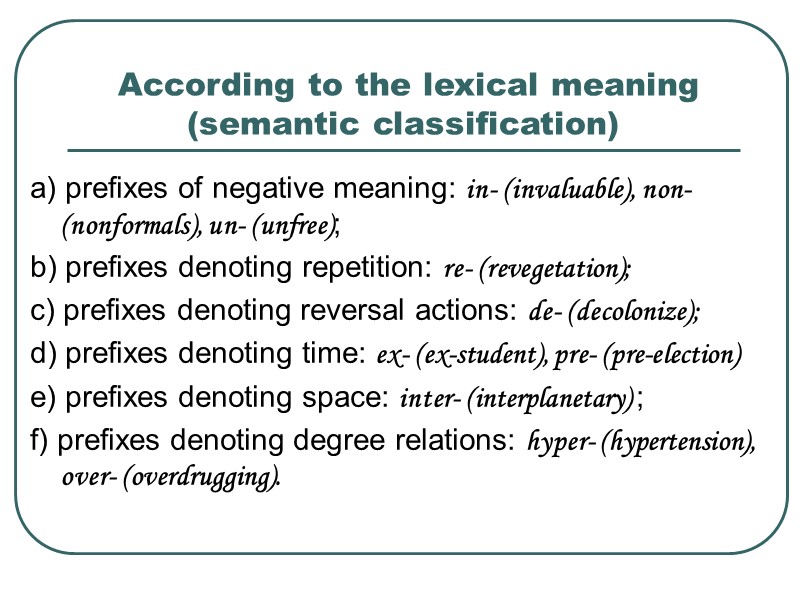
According to the lexical meaning (semantic classification) a) prefixes of negative meaning: in- (invaluable), non- (nonformals), un- (unfree); b) prefixes denoting repetition: re- (revegetation); c) prefixes denoting reversal actions: de- (decolonize); d) prefixes denoting time: ex- (ex-student), pre- (pre-election) e) prefixes denoting space: inter- (interplanetary) ; f) prefixes denoting degree relations: hyper- (hypertension), over- (overdrugging).
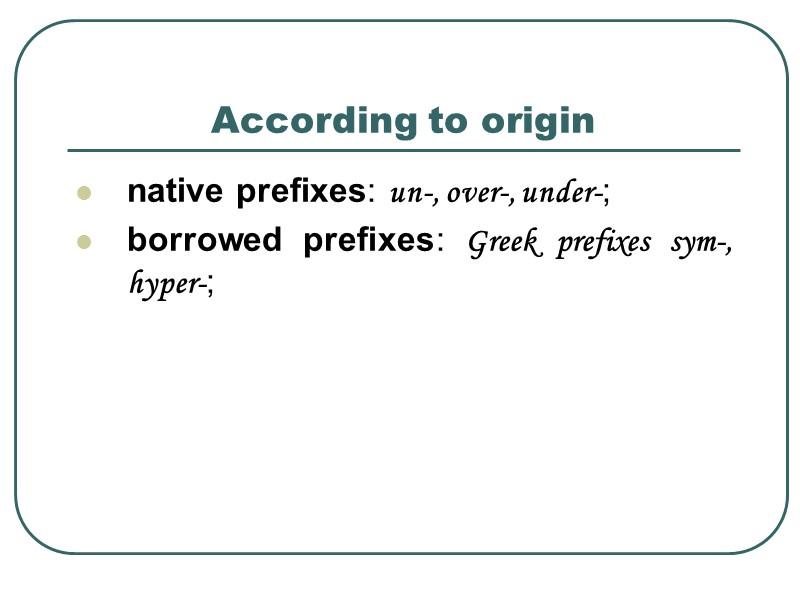
According to origin native prefixes: un-, over-, under-; borrowed prefixes: Greek prefixes sym-, hyper-;
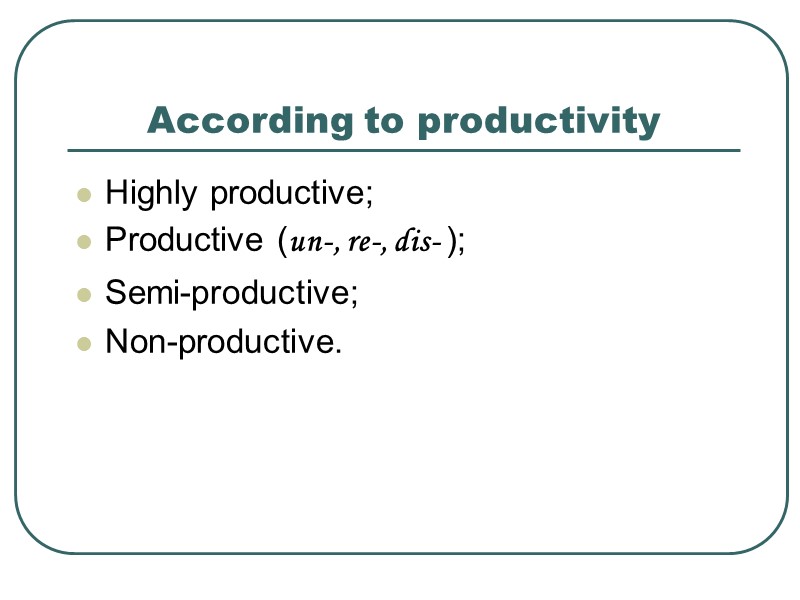
According to productivity Highly productive; Productive (un-, re-, dis- ); Semi-productive; Non-productive.
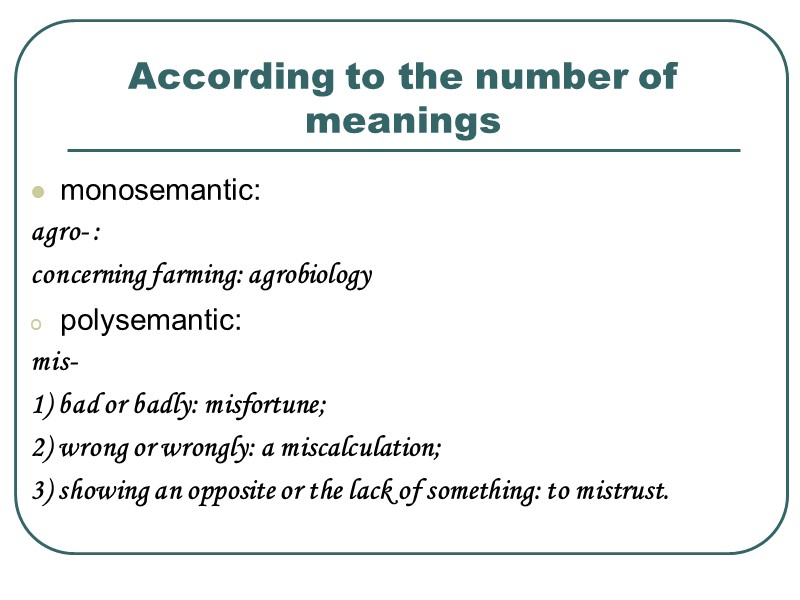
According to the number of meanings monosemantic: agro- : concerning farming: agrobiology polysemantic: mis- 1) bad or badly: misfortune; 2) wrong or wrongly: a miscalculation; 3) showing an opposite or the lack of something: to mistrust.
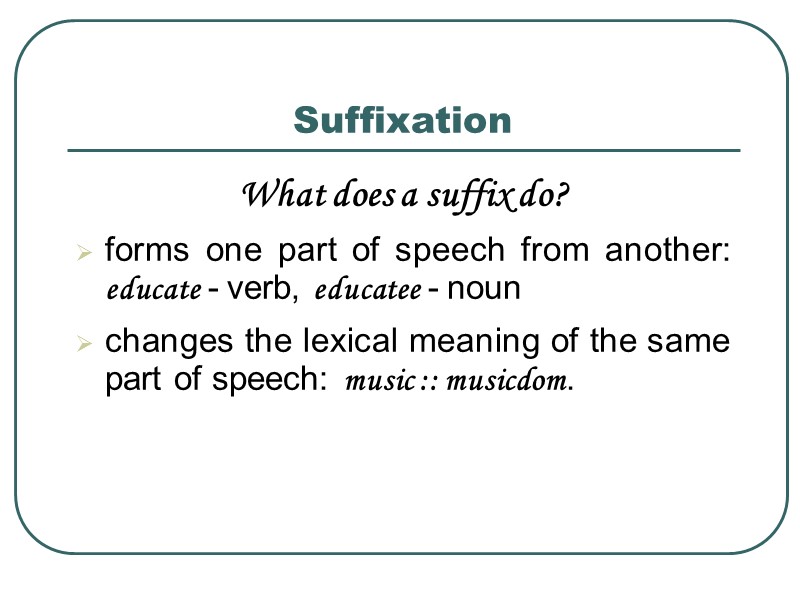
Suffixation What does a suffix do? forms one part of speech from another: educate - verb, educatee - noun changes the lexical meaning of the same part of speech: music :: musicdom.
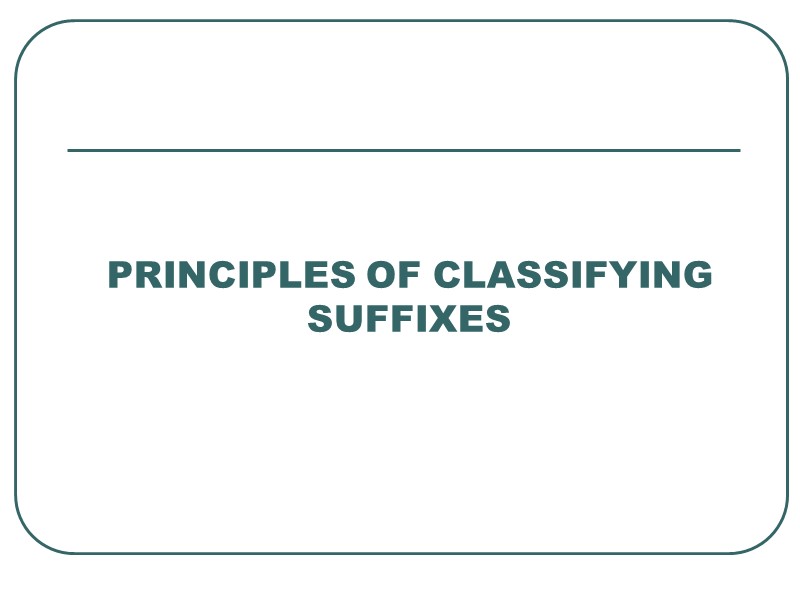
PRINCIPLES OF CLASSIFYING SUFFIXES

Part-of-speech classification a) noun-forming suffixes: -er (criticizer), -dom (officialdom), -ism (ageism); b) adjective-forming suffixes: -able (breathable), less (symptomless), -ous (prestigious); c) verb-forming suffixes: -ize (computerize) , -ify (micrify); d) adverb-forming suffixes: -ly (singly), -ward (tableward); e) numeral-forming suffixes: -teen (sixteen), -ty (seventy).
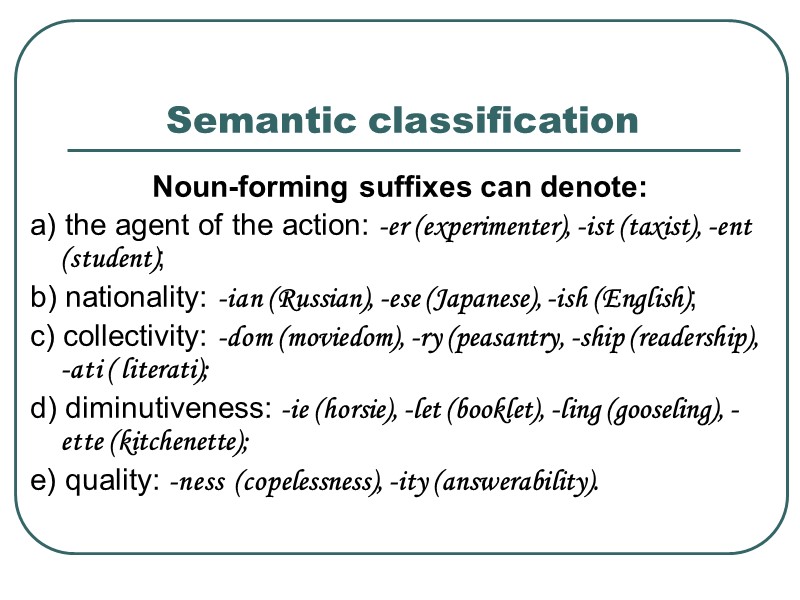
Semantic classification Noun-forming suffixes can denote: a) the agent of the action: -er (experimenter), -ist (taxist), -ent (student); b) nationality: -ian (Russian), -ese (Japanese), -ish (English); c) collectivity: -dom (moviedom), -ry (peasantry, -ship (readership), -ati ( literati); d) diminutiveness: -ie (horsie), -let (booklet), -ling (gooseling), -ette (kitchenette); e) quality: -ness (copelessness), -ity (answerability).
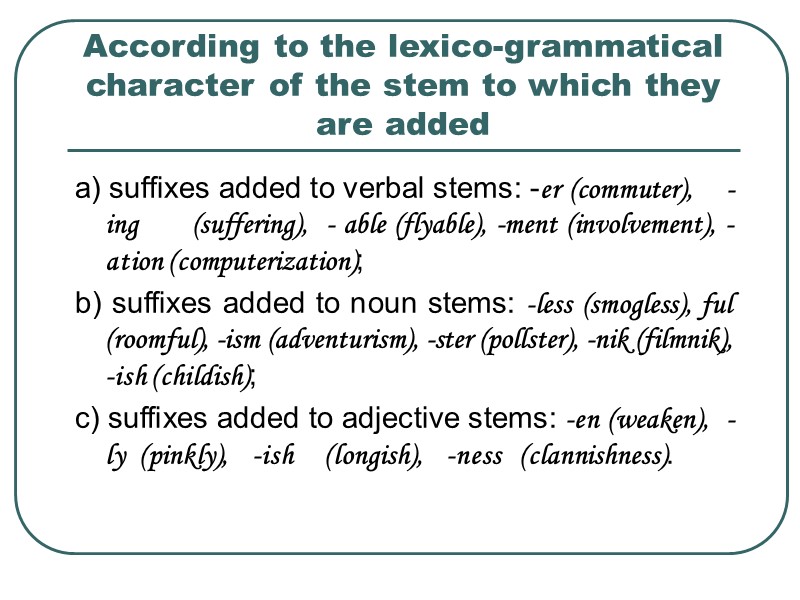
According to the lexico-grammatical character of the stem to which they are added a) suffixes added to verbal stems: -er (commuter), -ing (suffering), - able (flyable), -ment (involvement), -ation (computerization); b) suffixes added to noun stems: -less (smogless), ful (roomful), -ism (adventurism), -ster (pollster), -nik (filmnik), -ish (childish); c) suffixes added to adjective stems: -en (weaken), -ly (pinkly), -ish (longish), -ness (clannishness).
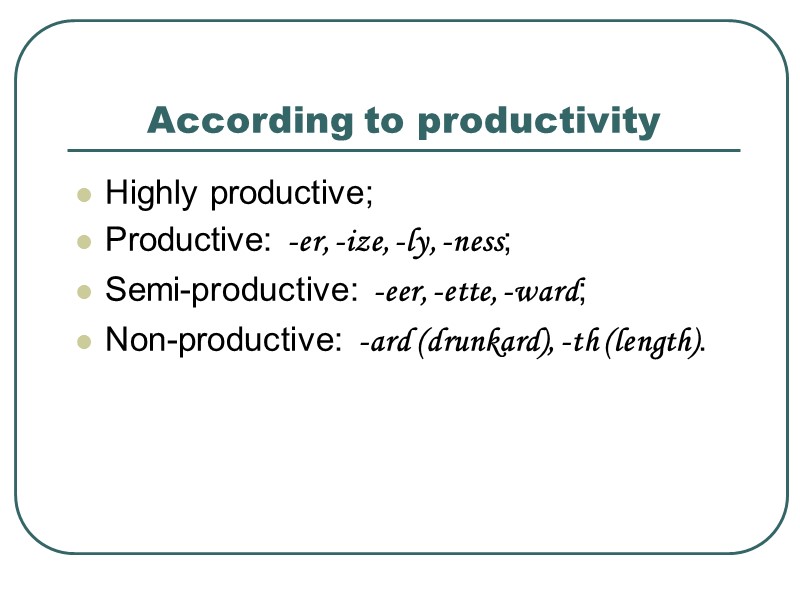
According to productivity Highly productive; Productive: -er, -ize, -ly, -ness; Semi-productive: -eer, -ette, -ward; Non-productive: -ard (drunkard), -th (length).
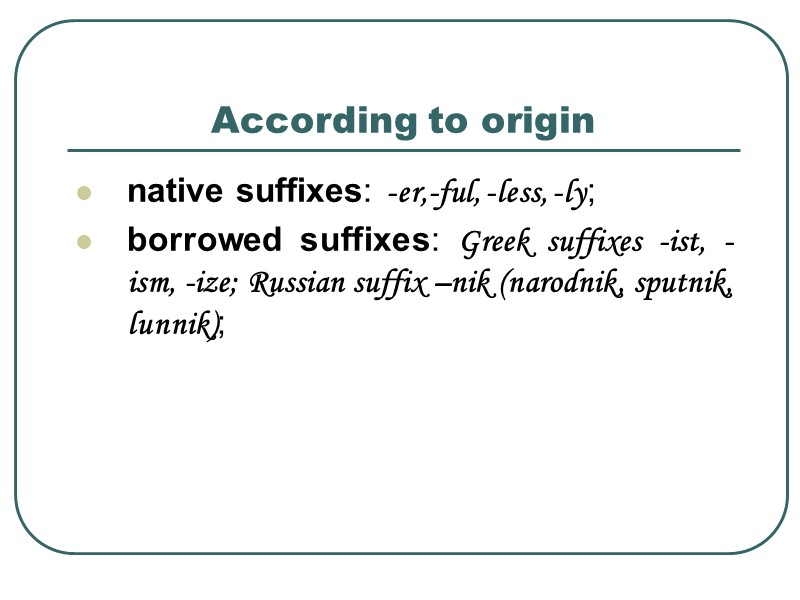
According to origin native suffixes: -er,-ful, -less, -ly; borrowed suffixes: Greek suffixes -ist, -ism, -ize; Russian suffix –nik (narodnik, sputnik, lunnik);
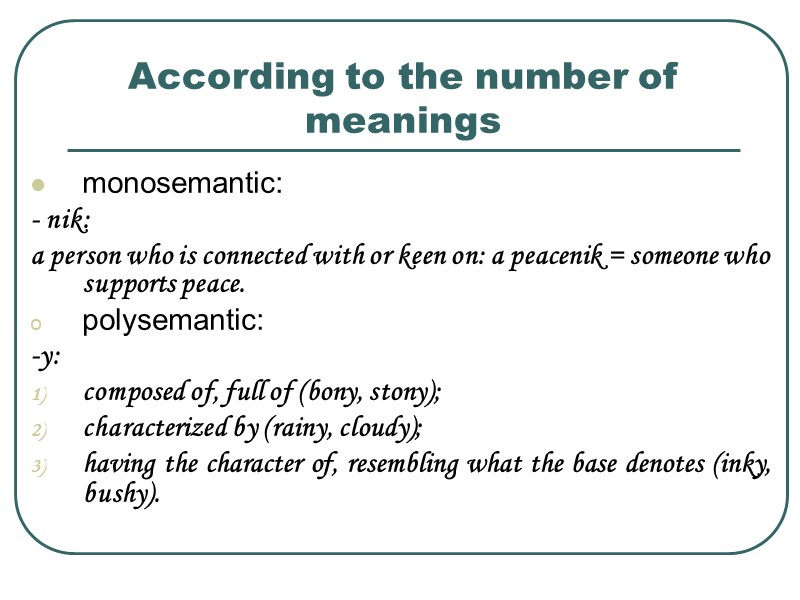
According to the number of meanings monosemantic: - nik: a person who is connected with or keen on: a peacenik = someone who supports peace. polysemantic: -y: composed of, full of (bony, stony); characterized by (rainy, cloudy); having the character of, resembling what the base denotes (inky, bushy).
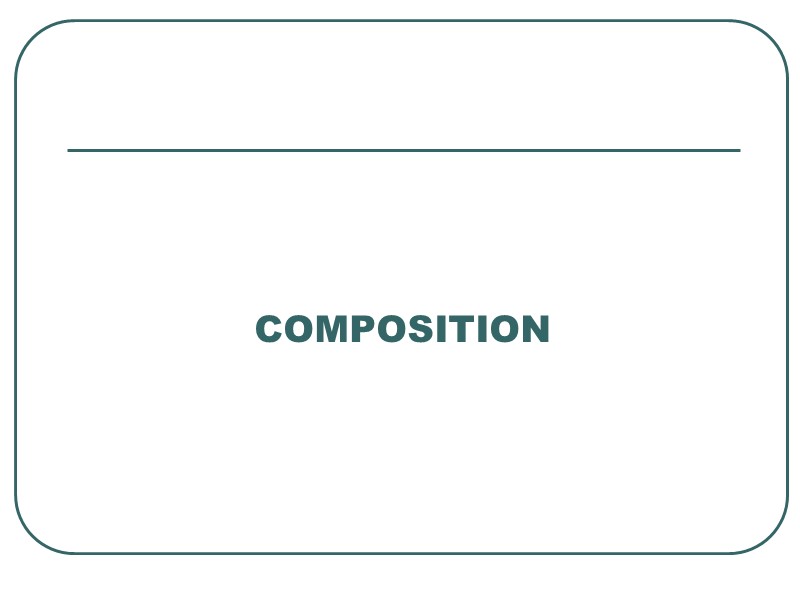
COMPOSITION
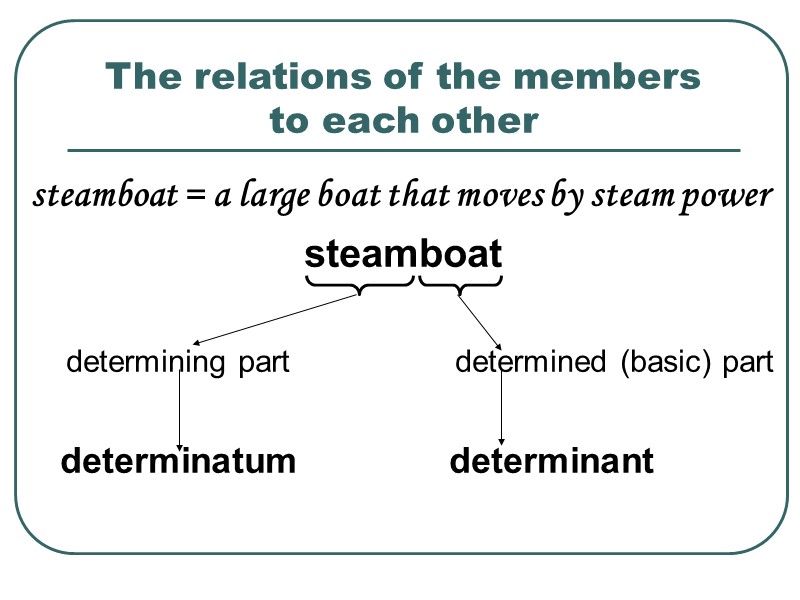
The relations of the members to each other steamboat = a large boat that moves by steam power steamboat determining part determined (basic) part determinatum determinant
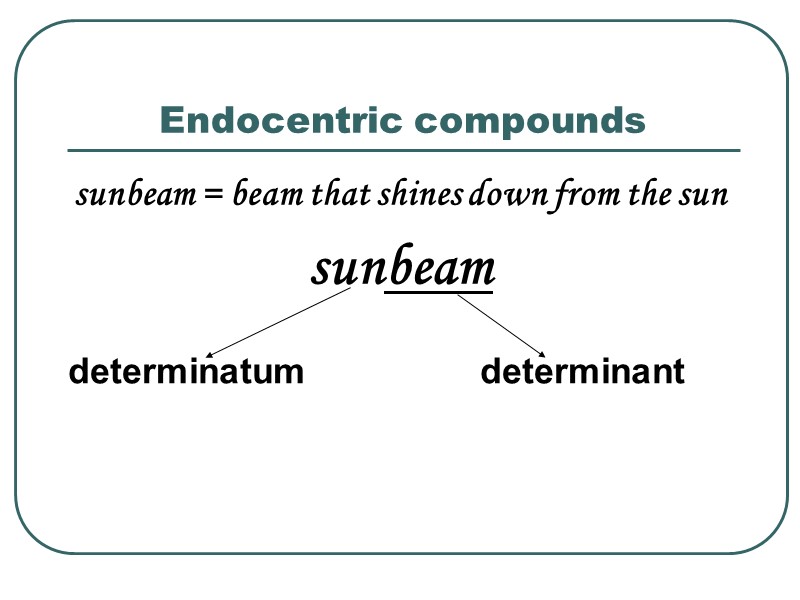
Endocentric compounds sunbeam = beam that shines down from the sun sunbeam determinatum determinant
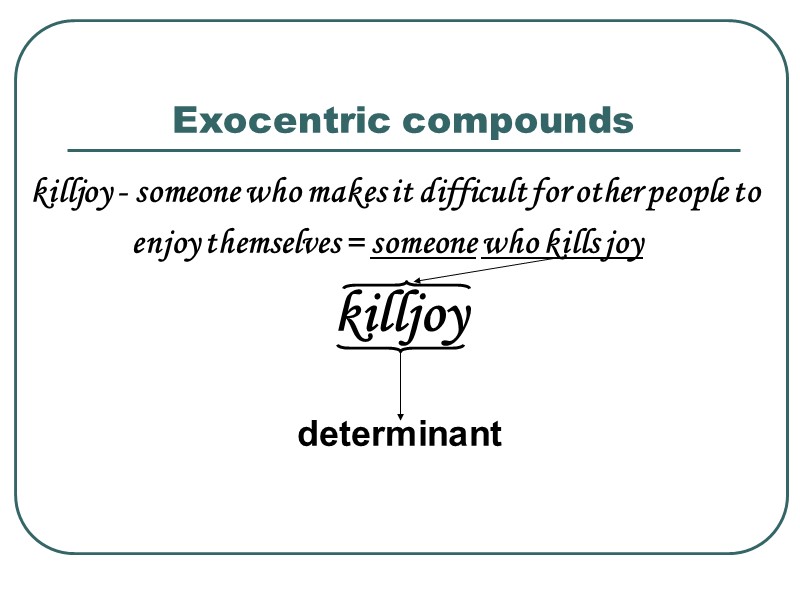
Exocentric compounds killjoy - someone who makes it difficult for other people to enjoy themselves = someone who kills joy killjoy determinant
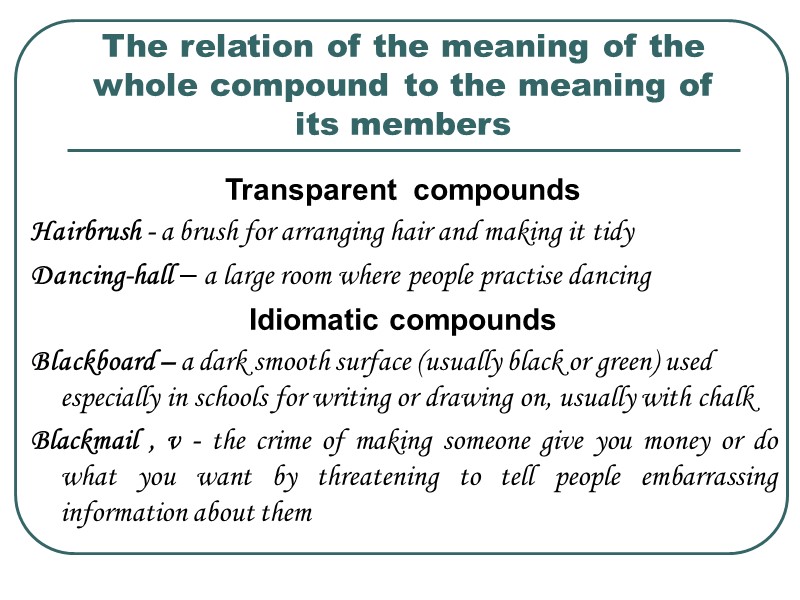
The relation of the meaning of the whole compound to the meaning of its members Transparent compounds Hairbrush - a brush for arranging hair and making it tidy Dancing-hall – a large room where people practise dancing Idiomatic compounds Blackboard – a dark smooth surface (usually black or green) used especially in schools for writing or drawing on, usually with chalk Blackmail , v - the crime of making someone give you money or do what you want by threatening to tell people embarrassing information about them
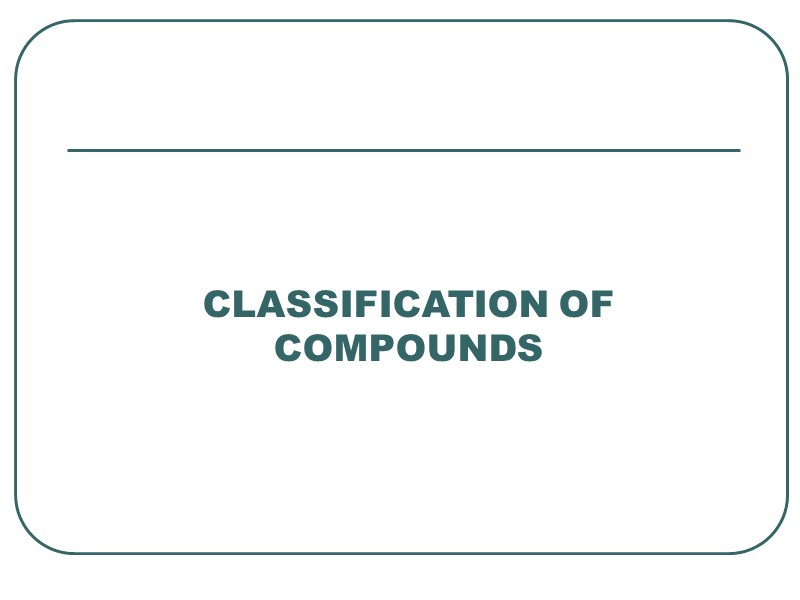
CLASSIFICATION OF COMPOUNDS
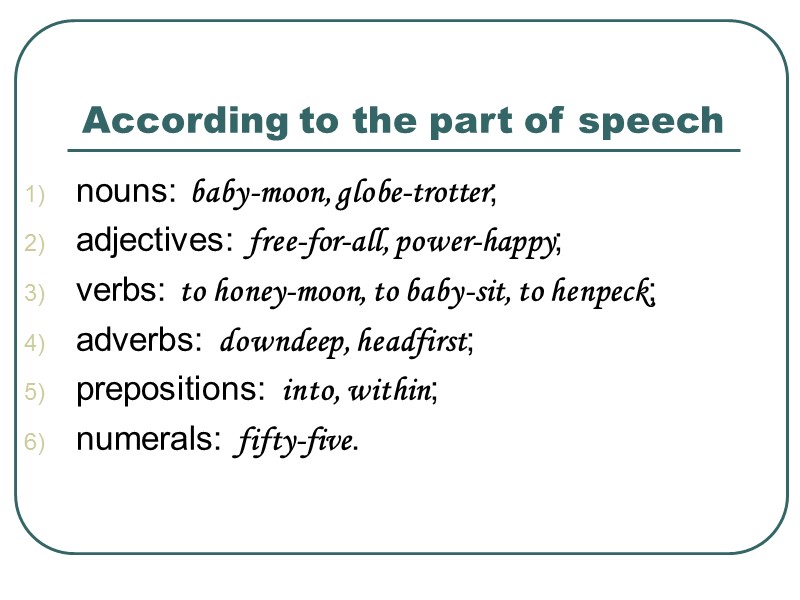
According to the part of speech nouns: baby-moon, globe-trotter; adjectives: free-for-all, power-happy; verbs: to honey-moon, to baby-sit, to henpeck; adverbs: downdeep, headfirst; prepositions: into, within; numerals: fifty-five.
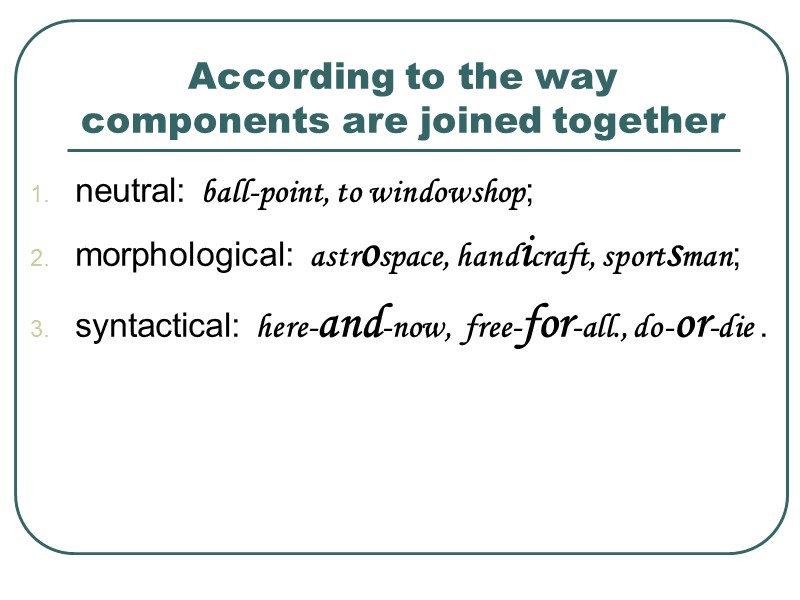
According to the way components are joined together neutral: ball-point, to windowshop; morphological: astrospace, handicraft, sportsman; syntactical: here-and-now, free-for-all., do-or-die .
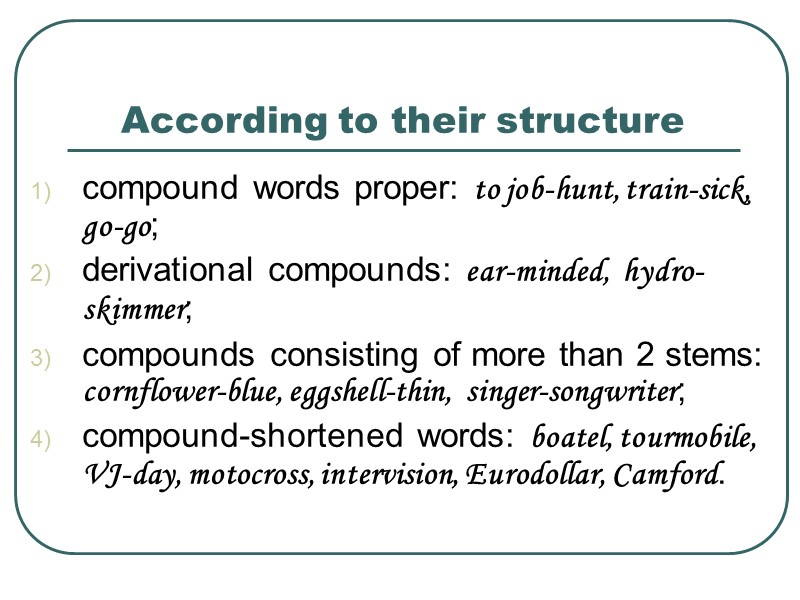
According to their structure compound words proper: to job-hunt, train-sick, go-go; derivational compounds: ear-minded, hydro-skimmer; compounds consisting of more than 2 stems: cornflower-blue, eggshell-thin, singer-songwriter; compound-shortened words: boatel, tourmobile, VJ-day, motocross, intervision, Eurodollar, Camford.
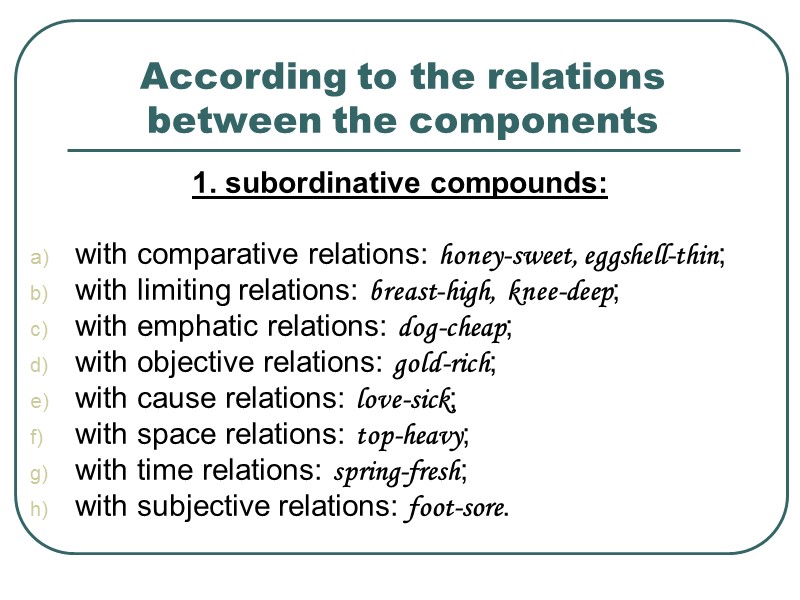
According to the relations between the components 1. subordinative compounds: with comparative relations: honey-sweet, eggshell-thin; with limiting relations: breast-high, knee-deep; with emphatic relations: dog-cheap; with objective relations: gold-rich; with cause relations: love-sick; with space relations: top-heavy; with time relations: spring-fresh; with subjective relations: foot-sore.
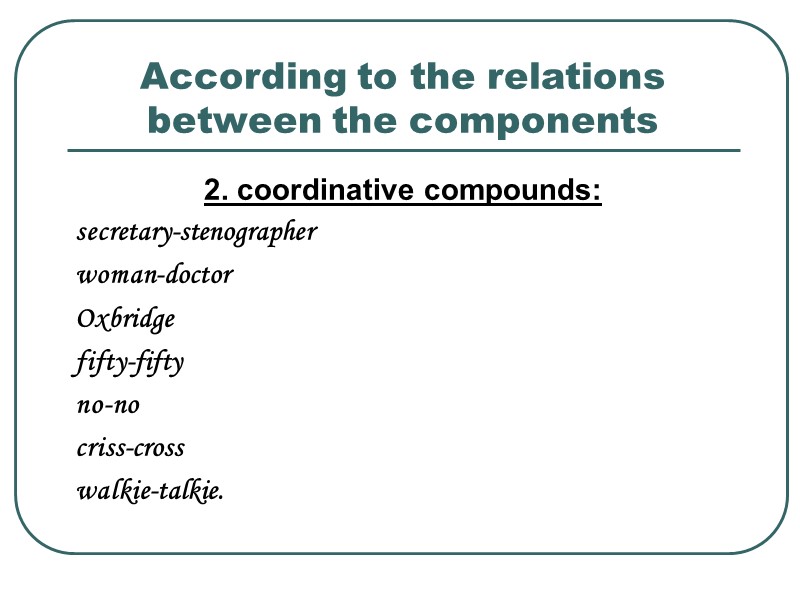
According to the relations between the components 2. coordinative compounds: secretary-stenographer woman-doctor Oxbridge fifty-fifty no-no criss-cross walkie-talkie.
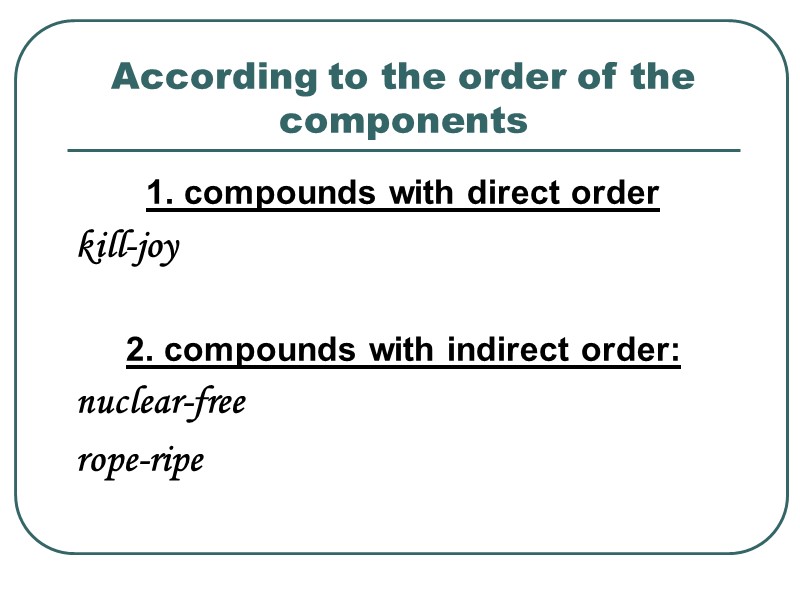
According to the order of the components 1. compounds with direct order kill-joy 2. compounds with indirect order: nuclear-free rope-ripe
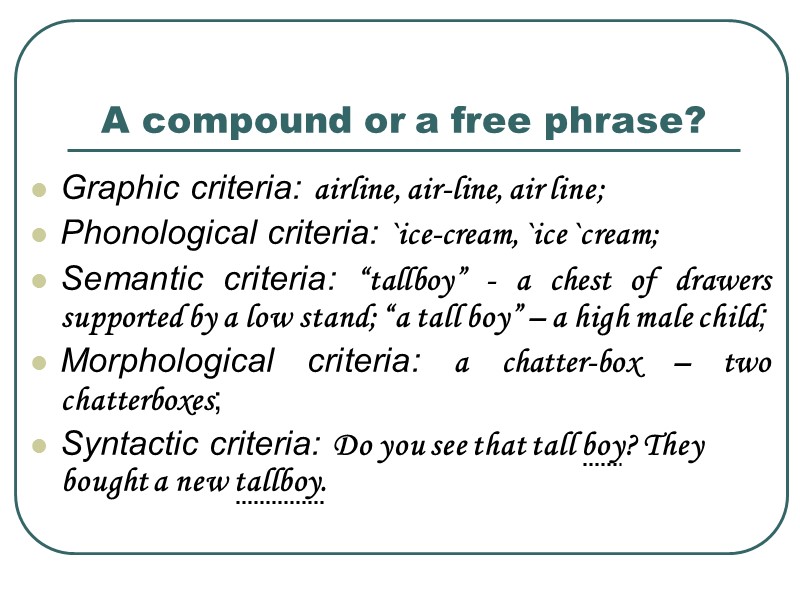
A compound or a free phrase? Graphic criteria: airline, air-line, air line; Phonological criteria: `ice-cream, `ice `cream; Semantic criteria: “tallboy” - a chest of drawers supported by a low stand; “a tall boy” – a high male child; Morphological criteria: a chatter-box – two chatterboxes; Syntactic criteria: Do you see that tall boy? They bought a new tallboy.

Conversion
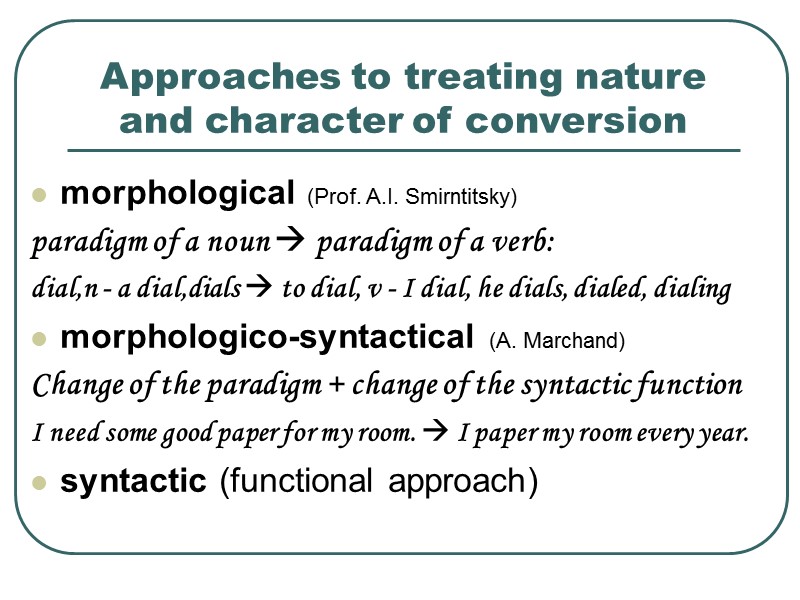
Approaches to treating nature and character of conversion morphological (Prof. A.I. Smirntitsky) paradigm of a noun paradigm of a verb: dial,n - a dial,dials to dial, v - I dial, he dials, dialed, dialing morphologico-syntactical (A. Marchand) Change of the paradigm + change of the syntactic function I need some good paper for my room. I paper my room every year. syntactic (functional approach)
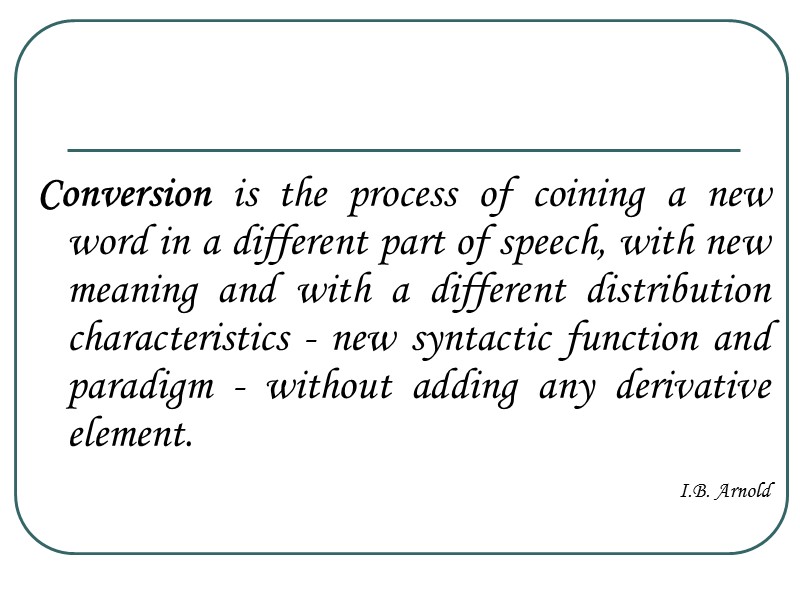
Conversion is the process of coining a new word in a different part of speech, with new meaning and with a different distribution characteristics - new syntactic function and paradigm - without adding any derivative element. I.B. Arnold
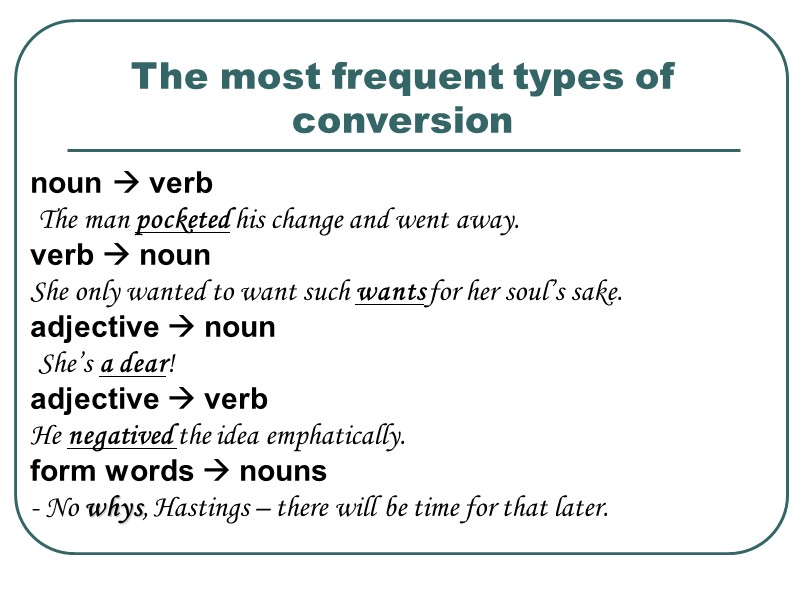
The most frequent types of conversion noun verb The man pocketed his change and went away. verb noun She only wanted to want such wants for her soul’s sake. adjective noun She’s a dear! adjective verb He negatived the idea emphatically. form words nouns - No whys, Hastings – there will be time for that later.
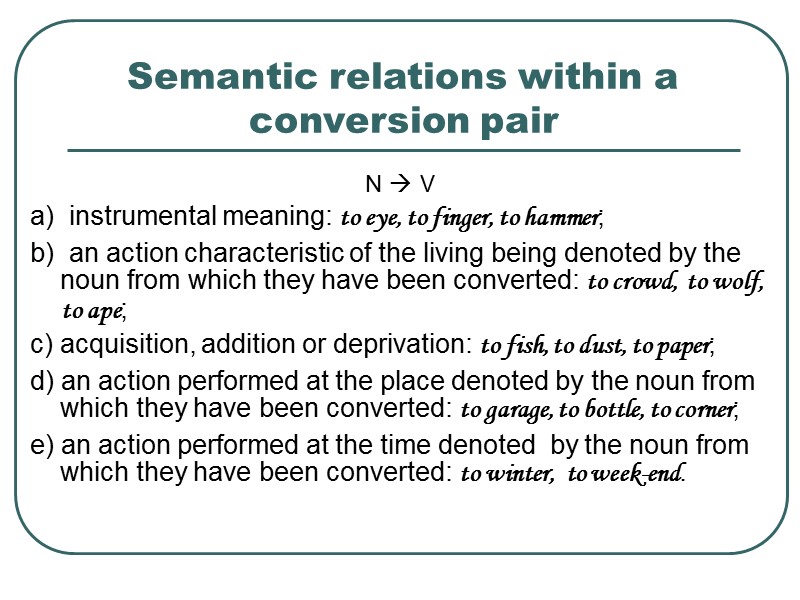
Semantic relations within a conversion pair N V a) instrumental meaning: to eye, to finger, to hammer; b) an action characteristic of the living being denoted by the noun from which they have been converted: to crowd, to wolf, to ape; c) acquisition, addition or deprivation: to fish, to dust, to paper; d) an action performed at the place denoted by the noun from which they have been converted: to garage, to bottle, to corner; e) an action performed at the time denoted by the noun from which they have been converted: to winter, to week-end.
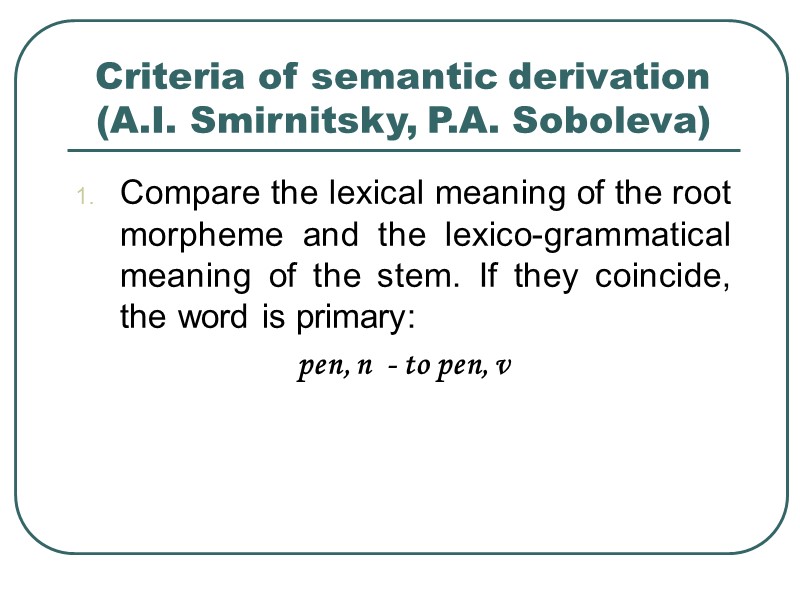
Criteria of semantic derivation (A.I. Smirnitsky, P.A. Soboleva) Compare the lexical meaning of the root morpheme and the lexico-grammatical meaning of the stem. If they coincide, the word is primary: pen, n - to pen, v
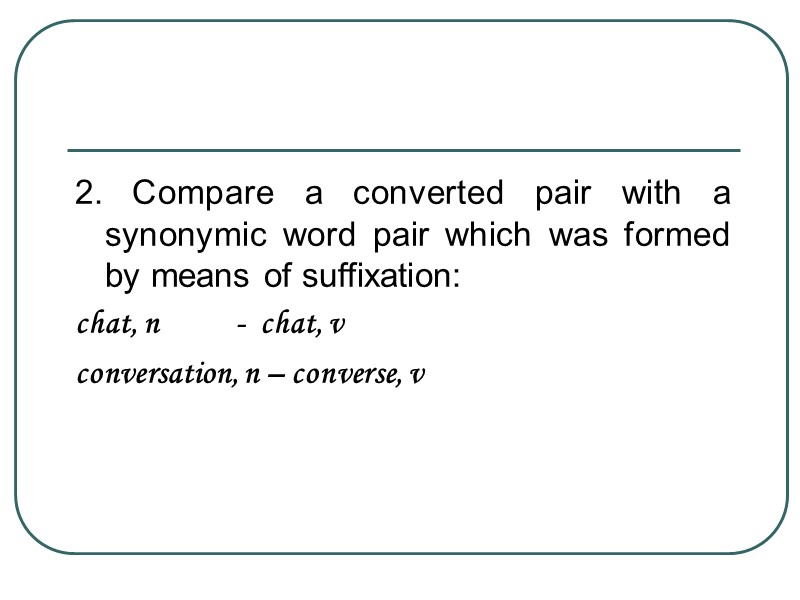
2. Compare a converted pair with a synonymic word pair which was formed by means of suffixation: chat, n - chat, v conversation, n – converse, v
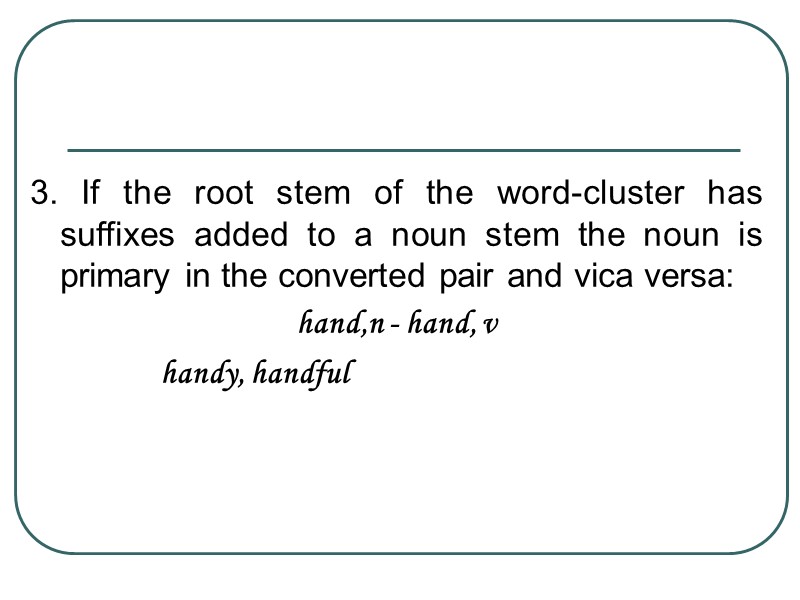
3. If the root stem of the word-cluster has suffixes added to a noun stem the noun is primary in the converted pair and vica versa: hand,n - hand, v handy, handful
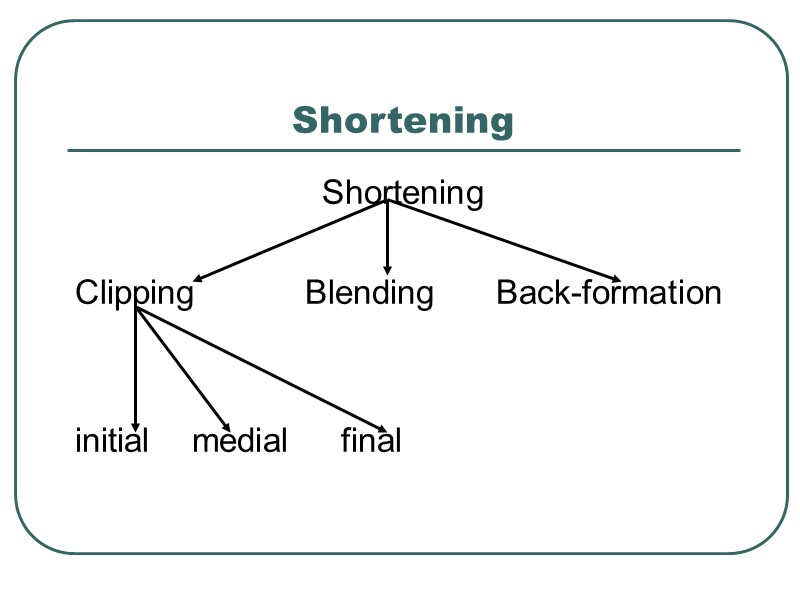
Shortening Shortening Clipping Blending Back-formation initial medial final
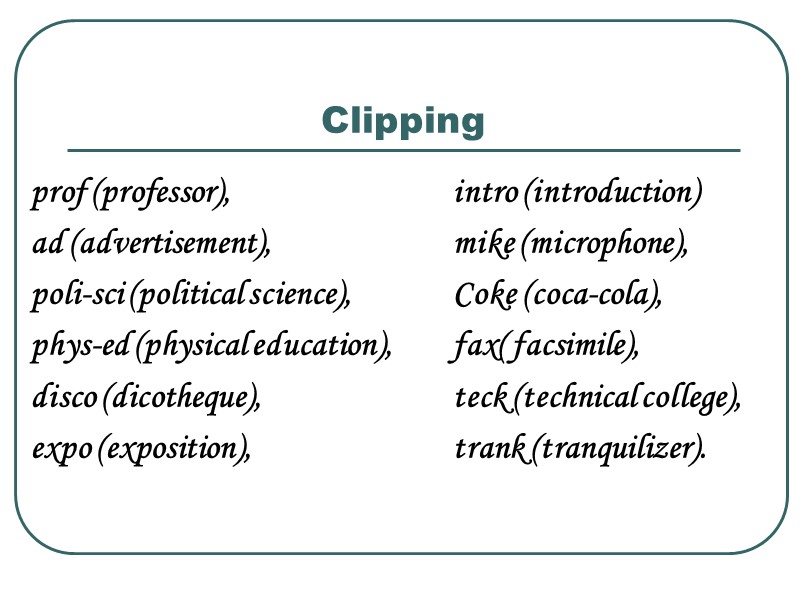
Clipping prof (professor), ad (advertisement), poli-sci (political science), phys-ed (physical education), disco (dicotheque), expo (exposition), intro (introduction) mike (microphone), Coke (coca-cola), fax( facsimile), teck (technical college), trank (tranquilizer).

Blending motel = motor + hotel, brunch = breakfast + lunch, selectric = select + electric, dancercise = dance + exercise.
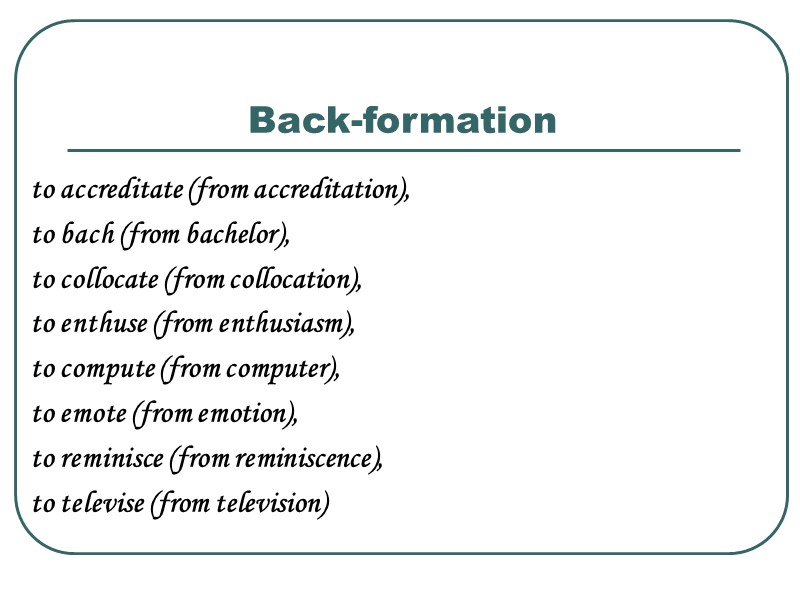
Back-formation to accreditate (from accreditation), to bach (from bachelor), to collocate (from collocation), to enthuse (from enthusiasm), to compute (from computer), to emote (from emotion), to reminisce (from reminiscence), to televise (from television)
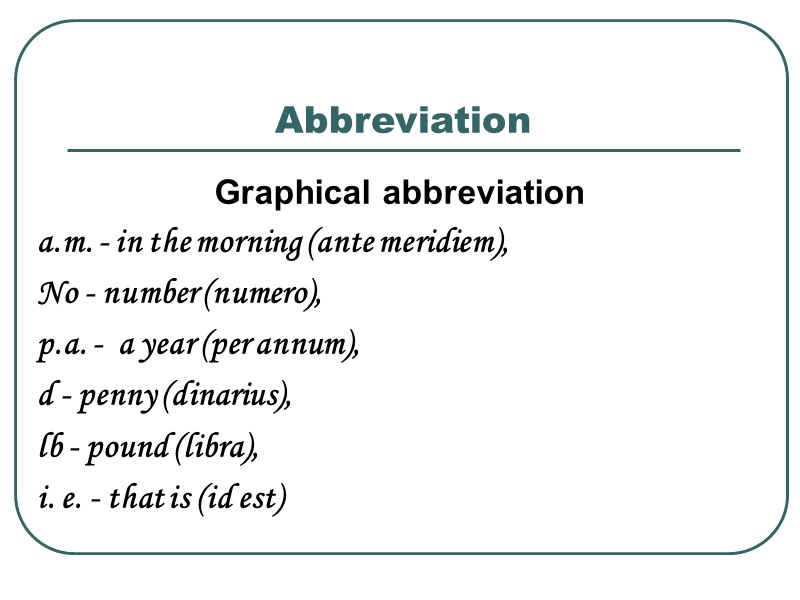
Abbreviation Graphical abbreviation a.m. - in the morning (ante meridiem), No - number (numero), p.a. - a year (per annum), d - penny (dinarius), lb - pound (libra), i. e. - that is (id est)
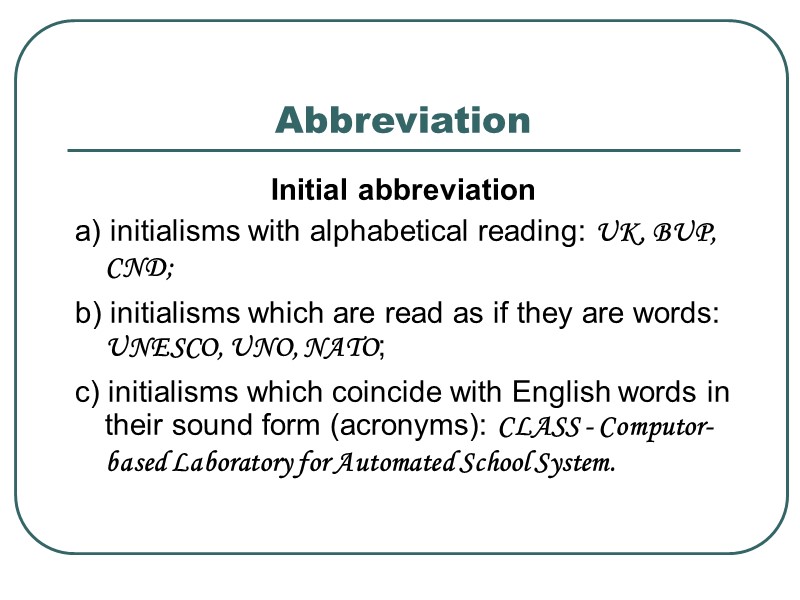
Abbreviation Initial abbreviation a) initialisms with alphabetical reading: UK, BUP, CND; b) initialisms which are read as if they are words: UNESCO, UNO, NATO; c) initialisms which coincide with English words in their sound form (acronyms): CLASS - Computor-based Laboratory for Automated School System.
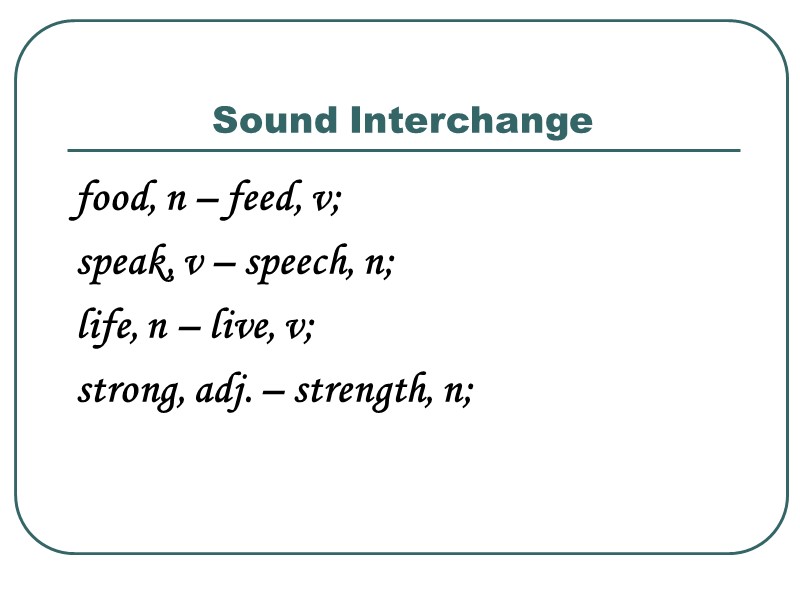
Sound Interchange food, n – feed, v; speak, v – speech, n; life, n – live, v; strong, adj. – strength, n;
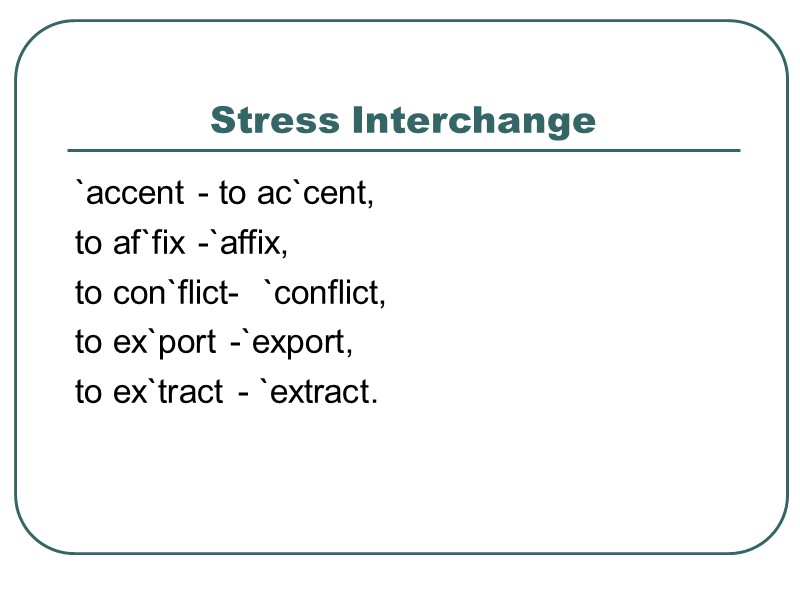
Stress Interchange `accent - to ac`cent, to af`fix -`affix, to con`flict- `conflict, to ex`port -`export, to ex`tract - `extract.
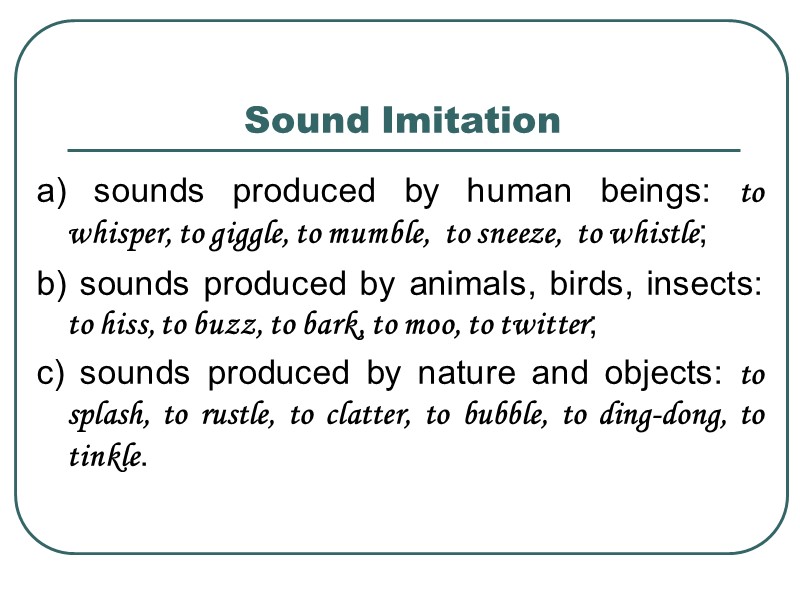
Sound Imitation a) sounds produced by human beings: to whisper, to giggle, to mumble, to sneeze, to whistle; b) sounds produced by animals, birds, insects: to hiss, to buzz, to bark, to moo, to twitter; c) sounds produced by nature and objects: to splash, to rustle, to clatter, to bubble, to ding-dong, to tinkle.
41246-word_formation.ppt
- Количество слайдов: 51

